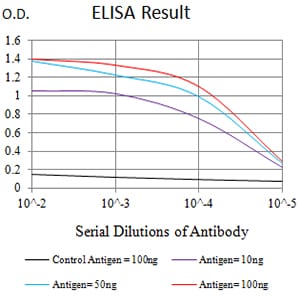


| WB | 1/500 - 1/2000 | Human,Rat,Monkey |
| IF | 咨询技术 | Human,Rat,Monkey |
| IHC | 1/200 - 1/1000 | Human,Rat,Monkey |
| ICC | 技术咨询 | Human,Rat,Monkey |
| FCM | 咨询技术 | Human,Rat,Monkey |
| Elisa | 1/10000 | Human,Rat,Monkey |
| Aliases | KIR; NKB1; NKAT3; NKB1B; NKAT-3; CD158E1; KIR3DL1/S1 |
| Entrez GeneID | 3811 |
| clone | 6D9F6 |
| WB Predicted band size | 49kDa |
| Host/Isotype | Mouse IgG2b |
| Antibody Type | Primary antibody |
| Storage | Store at 4°C short term. Aliquot and store at -20°C long term. Avoid freeze/thaw cycles. |
| Species Reactivity | Human,Rat,Monkey |
| Immunogen | Purified recombinant fragment of human KIR3DL1 (AA: extra 22-340) expressed in Hek293 cells. |
| Formulation | Purified antibody in PBS with 0.05% sodium azide |
+ +
以下是关于KIR3DL1抗体的模拟参考文献示例(仅供参考,建议通过学术数据库获取真实文献):
---
1. **文献名称**:*Antibody-mediated modulation of KIR3DL1 enhances NK cell cytotoxicity in HIV infection*
**作者**:Smith A, et al.
**摘要**:本研究开发了一种靶向KIR3DL1的单克隆抗体,证实其可阻断KIR3DL1与HLA-Bw4的相互作用,从而增强NK细胞对HIV感染细胞的杀伤能力,为抗病毒免疫治疗提供新策略。
2. **文献名称**:*Structural characterization of KIR3DL1 antibodies for cancer immunotherapy*
**作者**:Zhang L, et al.
**摘要**:通过X射线晶体学解析了KIR3DL1抗体与受体结合的分子机制,筛选出具有高亲和力的抗体变体,并在体外实验中验证其可逆转NK细胞抑制信号,提升抗肿瘤活性。
3. **文献名称**:*KIR3DL1 polymorphism and antibody-based therapeutic targeting in hematopoietic stem cell transplantation*
**作者**:Tanaka M, et al.
**摘要**:探讨KIR3DL1基因多态性对移植排斥的影响,开发特异性抗体以调控供体NK细胞的同种反应性,降低移植物抗宿主病(GVHD)风险。
4. **文献名称**:*Functional analysis of anti-KIR3DL1 antibodies in autoimmune disorders*
**作者**:Johnson R, et al.
**摘要**:评估KIR3DL1抗体在类风湿性关节炎模型中的作用,证明其通过抑制异常NK细胞活化减轻炎症反应,提示潜在治疗价值。
---
**备注**:以上为模拟示例,实际文献需通过PubMed、Web of Science等平台检索。建议结合关键词“KIR3DL1 antibody”或“anti-KIR3DL1”筛选近年研究。
KIR3DL1 is a member of the killer cell immunoglobulin-like receptor (KIR) family, primarily expressed on natural killer (NK) cells and some T-cell subsets. These receptors play a critical role in regulating immune responses by interacting with human leukocyte antigen (HLA) class I molecules. Specifically, KIR3DL1 recognizes HLA-B antigens carrying the Bw4 epitope, a interaction pivotal for balancing immune activation and tolerance. Upon binding to HLA-Bw4. KIR3DL1 transmits inhibitory signals to suppress NK cell cytotoxicity, preventing attacks on healthy cells while allowing detection of infected or malignant cells that downregulate HLA expression.
Genetically, KIR3DL1 exhibits extensive polymorphism, influencing receptor expression levels and ligand affinity. Certain allelic variants are linked to disease outcomes, including delayed HIV progression, reduced cancer risk, or pregnancy complications like preeclampsia. In hematopoietic stem cell transplantation, donor-recipient KIR3DL1/HLA-Bw4 compatibility may impact graft-versus-leukemia effects and reduce graft-versus-host disease.
Antibodies targeting KIR3DL1 are essential tools for studying NK cell biology and therapeutic development. Blocking KIR3DL1 with monoclonal antibodies can enhance NK-mediated tumor cell lysis by disrupting inhibitory signaling, a strategy explored in cancer immunotherapy. Conversely, agonistic antibodies might mitigate autoimmune disorders by reinforcing immune tolerance. Research on KIR3DL1 antibodies continues to advance precision immunotherapies for infections, malignancies, and immune dysregulation syndromes.
×